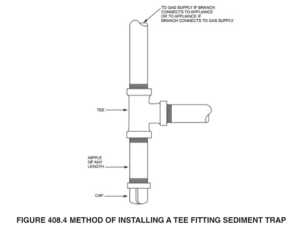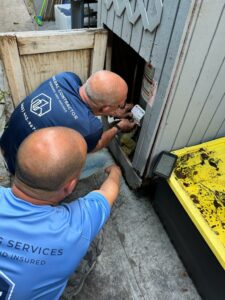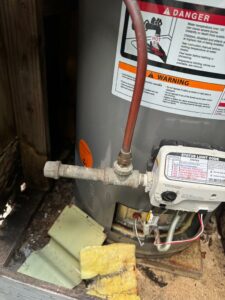What Are Sediment Traps?
You’ve likely heard about sediment traps, but do you really know what they are or why they’re important?
In this article, you’ll dive into the nitty-gritty of sediment traps, understand their function, learn how to install them, and discover why maintaining them is crucial.
Don’t ignore these handy devices; they’re more significant to your home’s safety than you might think.
Let’s unravel the mysteries of sediment traps together.
Key Takeaways
- Sediment traps are an essential part of a gas system, preventing debris from entering gas appliances and ensuring their longevity and efficiency.
- There are two main types of sediment traps: dry traps for low-pressure applications and wet traps for high-pressure systems. The choice of trap depends on the specific system requirements.
- Proper installation of sediment traps is crucial, with the trap being placed downstream of the gas appliance to catch sediment before it reaches the equipment. Professional installation may be necessary, but the long-term savings justify the initial cost.
- Regular maintenance and troubleshooting are important for sediment traps. Regular cleaning and inspection help prevent sediment buildup and potential damage, and immediate troubleshooting and consultation with professionals are advised if sediment issues persist.
Understanding Sediment Traps
Why should you care about sediment traps?
Well, they’re a vital part of your home’s gas system, designed to collect and prevent sediment from entering gas appliances, which could cause significant damage or even failure. Understanding sediment trap types and sediment trap laws is essential for maintaining a safe and efficient home environment.
There are two main types of sediment traps: dry and wet.
Dry traps are typically used in low-pressure applications, while wet traps are ideal for high-pressure systems.
As for laws, most states require the installation of sediment traps in residential properties. Non-compliance could lead to hefty fines or legal action.
The Function of Sediment Traps
The primary function of a sediment trap in your home’s gas system is to catch and stop debris and moisture from entering and potentially damaging your gas appliances. This is crucial in maintaining the longevity and efficiency of these appliances.
- Trap Efficiency
Sediment traps are built to efficiently capture unwanted substances. They prevent these substances from infiltrating your gas system and causing potential harm.
- Sediment Types
Trap efficiency varies depending on the sediment types. Common sediment types include dust, dirt, and rust particles, all of which can be harmful to your gas appliances.
- Functionality
The trap’s functionality relies on gravity. Sediments, being heavier than gas, fall into the trap, preventing them from entering your appliances.
Installing a Sediment Trap
After getting a grasp on the function of sediment traps in your home, you’re probably ready to dive into the process of installing one. Understanding trap placement strategies is integral to this process. Your trap should be installed downstream of your gas appliance, ensuring it catches any sediment before it reaches and potentially damages your equipment.
However, don’t overlook cost considerations. While sediment traps aren’t particularly expensive, professional installation can add to the total cost. Yet, the long-term savings of avoiding appliance damage can justify this initial outlay.
Case Study: Gas Water Heater Damaged because of a bad Sediment Trap installation
The JMK Plumbing team showed up at a house in Miami Beach to resolve a water heater issue. We looked at several potential problems such as gas supply, leaks, pilot light, and water tank among the issues. The water heater was not installed properly following the building/plumbing code. The gas trap didn’t have the proper orientation and as a result sediment was entering the pilot.
Per the code (Fuel Gas 7th Edition Section 408.4) below is the proper installation of the sediment trap where debris would fall into the bottom trap before it goes into the water heater system.

Florida Code Gas Sediment Trap
In the photo below, our team took on from the water heater installation. The installation that was done original is wrong and not up to code. That’s the kind of issues that JMK Plumbing has to do to bring prior installations up to code.
For more details on the code for sediment trap installation, follow this link: Florida code on sediment trap installation

JMK Plumbing team at work on a gas water heater

Wrongful installation of a sediment trap for a gas water heater
https://youtube.com/live/ZNNNdcRkOHU
Maintenance and Troubleshooting
Once you’ve installed your sediment trap, it’s crucial to understand the importance of regular maintenance and how to troubleshoot potential Sediment Issues. Here’s a quick guide:
- Trap Cleaning
- Empty the trap regularly to prevent buildup.
- Use a specialized tool or hire a professional for thorough cleaning.
- Identifying Sediment Issues
- Look for signs such as decreased water flow or discoloration.
- Regular inspection can help detect sediment buildup early.
- Troubleshooting
- If you notice any sediment issues, clean the trap immediately.
- If problems persist after cleaning, consult a professional.
Risks of Ignoring Sediment Traps
Ignoring your sediment trap can lead to serious problems that might affect your home’s plumbing system. This trap negligence may result in sediment hazards that can damage your appliances and cause malfunctions in your gas systems.
Here’s a quick look at the possible ramifications of disregarding your sediment trap:
| Impact of Trap Negligence | Sediment Hazards |
|---|---|
| Damage to appliances | Sediment build-up can cause wear and tear to your appliances, reducing their efficiency and lifespan |
| Gas system malfunction | Accumulated sediment can block the gas flow, leading to system failures |
| Increased maintenance costs | Regular repairs and replacements due to damage can be costly |
| Safety risks | Blockages can cause gas leaks, posing a serious safety risk |
Avoid these problems by regularly checking and maintaining your sediment trap.
Frequently Asked Questions
What Is the Typical Cost of Installing a Sediment Trap?
The typical cost of installing a sediment trap varies. It’s influenced by the sediment trap’s efficiency and maintenance costs. You’ll need to consider labor charges, material costs, and upkeep expenses for a precise estimate.
Can a Sediment Trap Be Installed by a Homeowner or Does It Require a Professional?
While you can technically install a sediment trap yourself, it’s not advised due to DIY installation risks. Sediment trap maintenance requires specific knowledge and skills, so it’s better to hire a professional.
Are There Different Types of Sediment Traps Available for Different Appliances?
Yes, there are different types of sediment traps available for various appliances. The trap’s efficiency and material selection depend on the specific appliance. You’ll want to choose the right one for your needs.
How Often Should a Sediment Trap Be Replaced?
You should inspect your sediment trap annually for efficiency. However, there’s no set replacement timeline. It’s based on trap efficiency analysis. If sediment trap maintenance reveals excessive buildup, it’s time for a replacement.
Are There Any Legal Requirements or Regulations Related to Sediment Traps?
Yes, sediment trap compliance and trap maintenance laws exist. They’re regulated by local building codes. You’ll need to check with your local authorities for the specific requirements in your area.
Conclusion
In conclusion, sediment traps are crucial for your gas appliance’s longevity and safety. By capturing debris, they prevent malfunction or damage.
Installing one isn’t too complex, but regular maintenance is key. Ignoring this small component can lead to big problems, so don’t underestimate its importance.
Remember, it’s not just about extending the life of your appliance, it’s about ensuring your home is safe. So, get that sediment trap checked and maintain it properly for peace of mind.